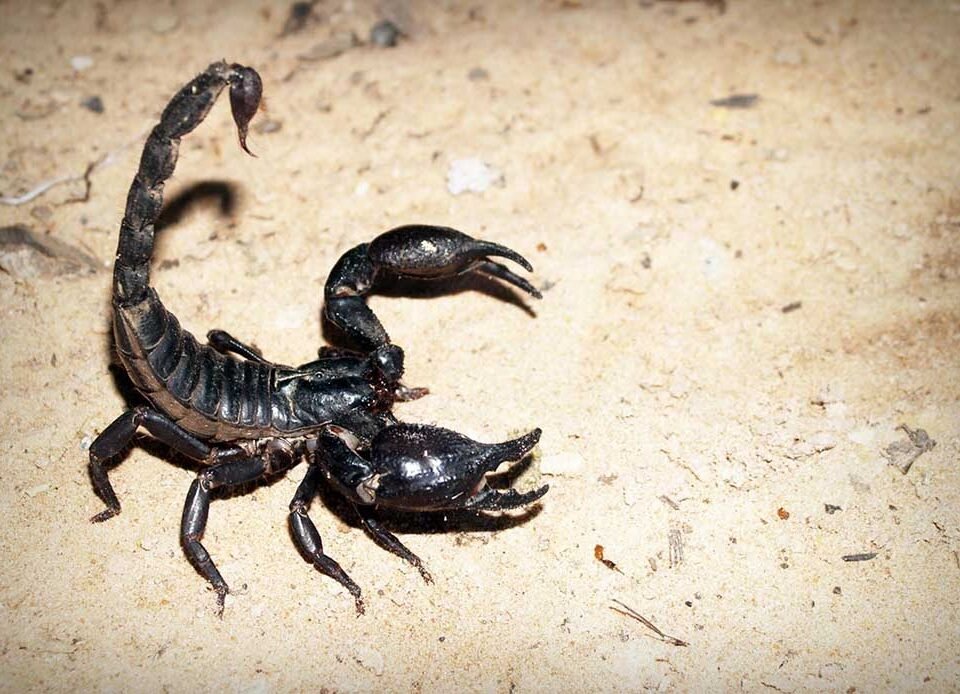You probably hope that you never run into a scorpion. At the same time, Arizona is full of these creatures.
If you’ve moved to the state recently, you want to know what creatures you should watch out for. A good way to get started learning about them is to learn about the types of scorpions in Arizona that you can find.
The good news is that many scorpions are nocturnal. But the bad news is you’re more likely to run into them at night.
Read on to learn the different types of scorpions that you can find and should watch out for in Arizona.
Table of Contents
Bark Scorpion
Bark scorpions are one of the most venomous scorpion species found in Arizona. Their common habitat includes areas such as rocks, under logs, and holes in the ground. They have a light brown color with visible stripes down its body.
This species of scorpion is usually no more than 3 inches in length and is very agile. The venom can cause pain, swelling, redness, and tingling in the area the sting occurred.
Symptoms can last for several days, and it is important to seek medical attention if bitten by a bark scorpion. They are predominantly found in the southern and lower elevation areas of Arizona.
Giant Hairy Scorpion
Reaching lengths of up to 4.5 inches, these have large, colorful bodies with yellow, orange, and reddish stripes. They live in rocky areas of the desert, beneath large rocks, and in dry caves. Although they are one of the larger scorpion species in Arizona, they are easy to identify due to their size and unique colorings.
The giant hairy scorpion is a solitary creature and rarely associates with other scorpions, only doing so for mating or other specific needs. These scorpions rarely attack people, and when they do it can be painful due to their large size and powerful claws. However, their venom is not known to be very toxic and most people can recover within a few days.
Stripe-Tailed Scorpion
This type of scorpion mostly lives in eastern, western, and northern areas of Arizona, and prefers dry, rocky areas. This species is sometimes called the devil’s spine because of its 12 to 13 black and yellow stripe-like markings on its tail.
It is also quite small, measuring from 1.2 to 2 inches long. Although they were able to give a nasty sting, the venom from this species is not lethal to adults.
The stripe-tailed scorpion is an omnivore, feeding on insects, spiders, and small lizards. It spends the day resting in cool, damp places and becomes active at night in search of food or to mate.
Desert Hairy Scorpion
The desert hairy scorpion is a type of scorpion found throughout Arizona. These arachnids are usually tan or yellow with darker stripes and spots and can grow 3 to 5 inches in length.
This type of scorpion has a painful bite that is said to be one of the worst among its relatives. The sting is intense and can cause an array of symptoms such as a burning sensation and swelling of the affected area.
For this reason, pest control services should be sought in the event of an encounter with this species of scorpion. Such services can help in the proper monitoring, identification, removal, and extermination of these creatures from residential and commercial areas.
Devil Scorpion
This species of scorpion is the largest in the world, measuring up to 8 inches long. It has a black body with yellow-brown striations, a large tail, and distinctive claws. This one of the types of scorpions is mainly nocturnal and resides in burrows in the ground.
Additionally, it is very protective of its burrows and can be quite aggressive when disturbed. Due to dangerous venom, people need to watch out and use caution when coming in contact with this type of scorpion. Fortunately, their venom is not very deadly to humans, but it can still cause pain, swelling, and even temporary paralysis.
Yellow Ground Scorpion
With its creamy yellow color and a light gold or yellowish-orange pattern on its back, the yellow ground scorpion is easy to recognize. These are medium-sized scorpions that usually grow to around 2 ¾ inches in length. They have pincers that are slightly longer than their tail and two large claws.
Like most scorpions, they feed on insects and other small animals but usually leave humans and other larger animals alone. This species of scorpion is usually found in dry areas such as deserts, hills, and mountains throughout Arizona.
These scorpions are nocturnal which means they hunt and feed mostly at night. Although they are relatively harmless to humans, they can still deliver a painful sting if provoked.
Stripe-Tailed Scorpion
The stripe-tailed scorpion generally grows to about 3 inches in length with variable color patterns across its body. It is an opportunistic predator that hunts small insects, as well as other arthropods. It is also known to feed on organic matter found in and around its home.
Most of this type of scorpion prefers dark, humid habitats but can also be found in the open desert and other dry regions. The venom is usually used for defense and is enough to cause a minor reaction but rarely inflict a more serious injury. They are very active at night when they forage for food and water and will often seek shelter out of the sun during the day.
Black Scorpion
The black scorpion is considered one of the Arizona pests that has a blackish-brown body and a maximum length of 5.5 inches. It is a large arachnid with four pairs of legs, an elongated body, a tail that has a venomous stinger, and two large pincers. Despite its intimidating physical features, this is not dangerous to humans and feeds principally on insects such as beetles and crickets.
This type of scorpion is active throughout the year and is nocturnal, avoiding the heat of the day. Although they tend to live alone, black scorpions form colonies when living conditions are optimal.
Discover the Types of Scorpions in Arizona
In conclusion, scorpions are a common pest in Arizona. They come in a variety of shapes and sizes. While some are large and formidable, others are small and relatively harmless.
When dealing with different types of scorpions in Arizona, it is important to take preventative measures as well as properly identify the species to ensure proper safety. Consider consulting a professional to learn more about proper scorpion control in Arizona.
If you find this helpful, take a look at our other blogs to learn more.










